I found myself in Bay Ridge a great deal in 2013, mainly because of extensive dental work, but the neighborhood, in which I lived from 1957-2003, is one I always enjoy visiting. It hasn’t been gentrified, yuppified or “Brooklynified” yet. It’s less Irish, Italian, Scandinavian and Syrian than it used to be, and more East Asian and Eastern European. Yet the basic DNA is the same, a mix of row houses, detached houses, and massive apartment buildings that date from the Golden Age of NYC Apartment Houses, about 1923-1935.
I live in Little Neck now, but the eastern Queens neighborhood has become increasingly anodyne. Its primary meeting place, the Scobee Diner, is gone, closed in November 2010 and razed in October 2013. Shops and bars have closed along Northern Boulevard. Even the OTB closed. Shaffer Funeral Home is still around, but funerary is a business that will never have hard times. Other neighborhoods attract, such as Astoria and Bay Ridge. But you can’t go home again. Except when you go to the dentist.
I haven’t paid much attention to Ridge Boulevard in the past, other than this ForgottenSlice in 2010. I decided to concentrate here on those blocks where Ridge Boulevard evolves from the almost suburban-like Bay Ridge to the gritty urbanity of Sunset Park. Even the name of the street changes, from Ridge Boulevard to 2nd Avenue. In Bay ridge, the numbered avenues begin at 3rd. There are three more north-south avenues west of 3rd, but they’re called Ridge Boulevard, Colonial Road, and Narrows Avenue, before the original shoreline at Shore Road is reached. Old maps — very old ones — show Ridge Boulevard and Colonial Road as 2nd and 1st Avenues, respectively, but I have a Kings County map showing 1st and 2nd Avenues in 1890 and Ridge and Colonial in 1910, so the change was made sometime in between.
I don’t know why the change was made. Bay Ridge was very much an outlying suburb until the 1920s, with rich nabobs’ mansions lining the shoreline, and scattered farms further inland. It wasn’t until the BMT Subway pushed south to 86th Street in 1915 did any massive real estate development happen, with side streets built up and ‘affordable’ houses lining them. I think we can be fairly assured, though, that RE development was the reason for the change.
Side streets of Bay Ridge are full of eclectic and handsome architecture like this group on 77th Street near Ridge Boulevard.

Bay Ridge doesn’t enjoy protection from the Landmarks Preservation Commission, so developers are free to tear down any building in the area. Whatever rises here won’t have nearly the personality of the three houses just shown.
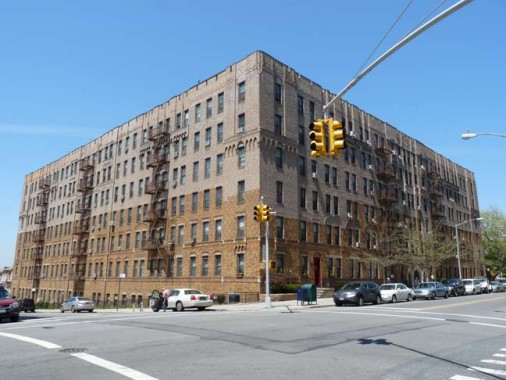
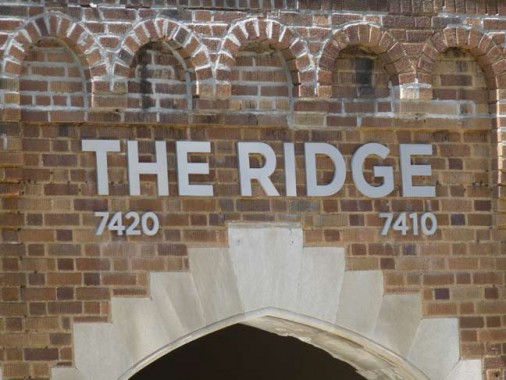
Many people in Bay Ridge call their neighborhood “The Ridge,” but this massive multifamily on Ridge Boulevard and 75th Street (they don’t call it Bay Ridge Parkway) has claimed the title. It’s so big, it has two addresses.
75th descends on a slope toward the Narrows. On its brother streets, 74th and 76th, the slope is too sharp an angle for vehicles, so steps streets were built.
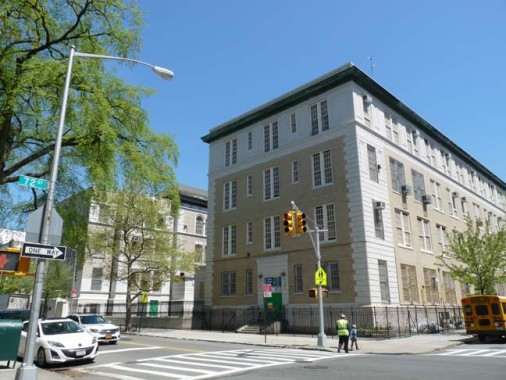
Skipping over Flagg Court, constructed by early 20th Century architect Ernest Flagg (it’s on this Ridge Boulevard page) you find an example from the golden age of public school architecture (in my opinion, 1900-1930) on 72nd Street, PS 102, known as the Bayview School. School architecture from the 1950s onward has made them look like prisons.
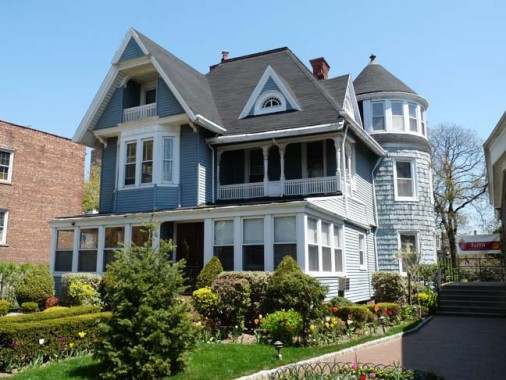
This Queen Anne-style house, just past Senator Street (Bay Ridge Avenue; over a dozen Bay Ridge Streets have “Bay,” “Ridge” or both in them) is the parish house for the St. Andrew the Apostle Catholic Church (founded in 1971; obviously a private residence was purchased for it). The church itself consists of a brick ground floor constructed around a pre-existing corner house in 1981. The parish was formed when the Bay Ridge Towers on 65th Street between 3rd and 4th Avenues was completed in 1971, overwhelming the pre-existing Our Lady of Angels (4th Avenue and 73rd Street) parish.
In the New Testament, Andrew was the brother of Simon Peter and shared his profession, fishing. According to tradition he shared the fate of Jesus Christ and Peter, that of crucifixion. Not considering himself worthy to be crucified on the T-shaped cross used for the Christ, he requested an X-shaped cross, today known as “St. Andrews’ Cross.” Such X-shaped crosses were included in the architecture of Manhattan’s st. Andrew’s Church at Foley Square.
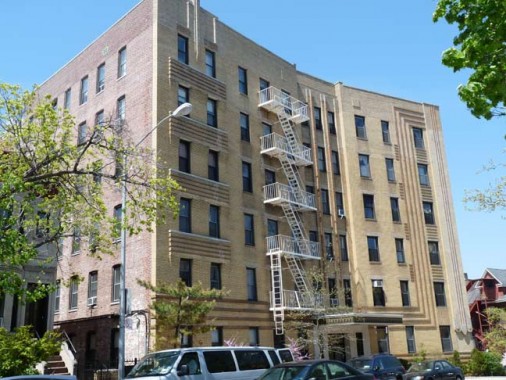
Art Deco apartment building at Ridge Boulevard and 67th Street. Notice the angle the building takes. It’s following a bend in Ridge Boulevard, the same bend that all north-south Bay Ridge Avenues take at 67th. In the late 1800s, 7th Avenue was laid out at a diagonal against the overall Brooklyn street grid south of 65th Street, and its brother avenues take an angle to remain parallel with it. I have an intriguing (OK, to me, at least) Beers Atlas of the town of New Utrecht from 1873, and it shows just a few streets traversing through what would be Bay Ridge. 3rd and 4th Avenues are already established, but 86th Street and 7th Avenue are just ghost lines.
As for the building itself, it features intricate brickwork and plenty of right angles in the facade.
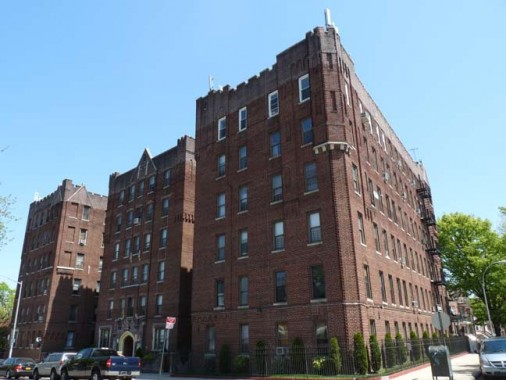
This multifamily at 6623 Ridge Boulevard was apparently inspired by medieval fortresses. If you have time on your hands for several months… count the bricks.

From 1938-1940 the Circumferential Parkway was constructed in western Brooklyn along the shoreline into Queens, joining a network of roads such as the Cross Island Parkway and Southern State Parkway. When that name proved to be too much of a mouthful, it was changed to the Belt Parkway, though highway and street signs call it Shore Parkway.
This overpass, dating to 1940 with several improvements since, originally connected the Belt Parkway to the Gowanus Parkway on 3rd Avenue, which was originally built between 38th and 65th streets in an ingenious manner: it used the pillars and supports of the old 5th Avenue Elevated train, which had switched to 3rd Avenue in Sunset Park. (New stanchions were built north of 38th Street.)
20th Century road czar Robert Moses was history’s greatest traffic mover, but he’s also remembered as a neighborhood destroyer. The uninterrupted shadows caused by the Gowanus Parkway over 3rd Avenue brought crime and economic depression, some say (especially Moses biographer Robert Caro) and brought on Sunset Park’s reputation as a place where, as my parents used to tell me as a kid, “the bad boys are.”

At the Belt Parkway overpass, as mentioned earlier, Ridge Boulevard becomes 2nd Avenue. I considered these street signs unusual — instead of the usual Highway Gothic or Clearview, the DOT street signs were made in Helvetica Bold.
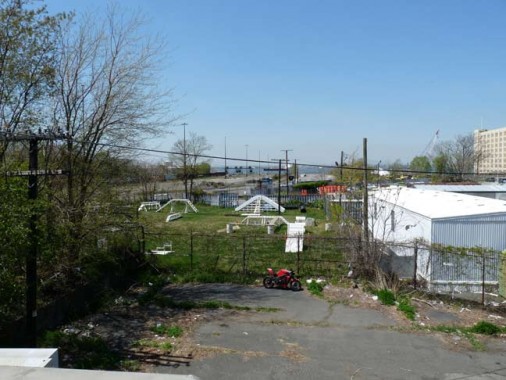
Ridge Boulevard is bridged over by the Belt Parkway, but itself is on a bridge that lasses over Shore Road Drive and the west end of the Bay Ridge branch of the Long Island Railroad, here officially the NY & Atlantic — and has been in place since the mid-1800s. The line ends at the Brooklyn Army Terminal and in the dim past was actually a passenger line. In 1958, by then an all-freight line, it nonetheless had a Very Important Passenger — more anon.
I once had a private trip on the entire Bay Ridge Branch, which ends at Fresh Pond Yards in Glendale, Queens.
This monolithic behemoth at the corner of 2nd and 64th Street looks like it could survive a couple of Hurricane Sandys. I wonder what its original purposes was. It is now home to Extra Space storage. The exterior is fenced off pretty securely. I stuck the camera through the bars for some photos.
The Brooklyn Army Terminal (officially, BKLYN Army Terminal) complex is a massive grouping, filling the area between the waterfront and 2nd Avenue between the railroad and 58th Street.
The complex was also known as the U.S. Army Military Ocean Terminal and the Brooklyn Army Base, as part of the New York Port of Embarkation. It was designed by Cass Gilbert and completed in September 1919. It was the largest military supply base in the United States through World War II. By the time the base was closed in the 1970s, over 3 million soldiers and 37 million tons of military supplies had passed through the terminal.The 95 acre complex had its own railroad line, police and fire departments. wikipedia
The Feds sold the complex to NYC in 1981, and since then it’s been home to light manufacturing, back offices and warehousing. Its interior open space is phantasmagorical. Unused train tracks connecting to the LIRR Bay Ridge branch can be found within. This was a major embarkation point for US troops heading to Europe and elsewhere in the draft days, and the draftees were often brought in from the mainland along the tracks. In 1958, one of the draftees was Elvis Presley, in probably his only Brooklyn appearance. A poster in the BAT foyer commemorates this occasion.
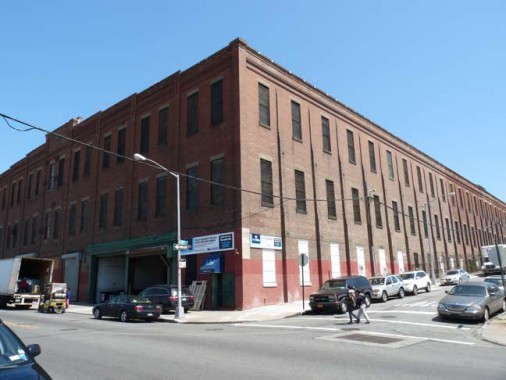
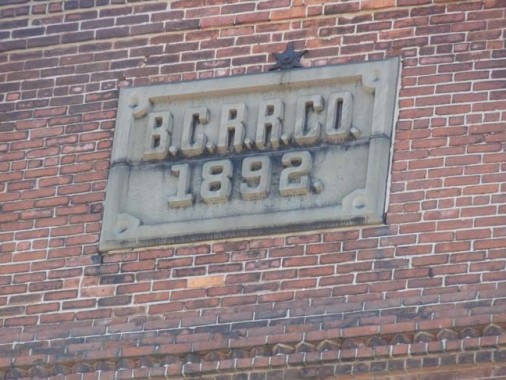
Yet another huge brick behemoth can be found occupying the entire block between 2nd and 3rd Avenue and 58th and 59th streets, and again occupied by a plethora of small businesses. What was its purpose? A clue can be found on some stone tablets by the roofline.
The Brooklyn City Railroad, incorporated in 1853, ran horsecar and later trolley lines in western Brooklyn for decades. This complex for repair and storage of the cars was built in 1892 at what was then the city of Brooklyn’s southern limit. The company continued to run Brooklyn’s trolleys until 1929, when the BMT (Brooklyn-Manhattan Transit) reformulated it into Brooklyn-Queens Transit. The boroughs’ trolley lines had disappeared by the mid-1950s.

“Directed Accident Response Program” and “Rotation Towing.” Where you collect your car when it’s been towed. 2nd Avenue and 62nd Street.

Pizzeria Cafe 58, serving breakfast and lunch, serves workers in the BKLYN Army Terminal complex.
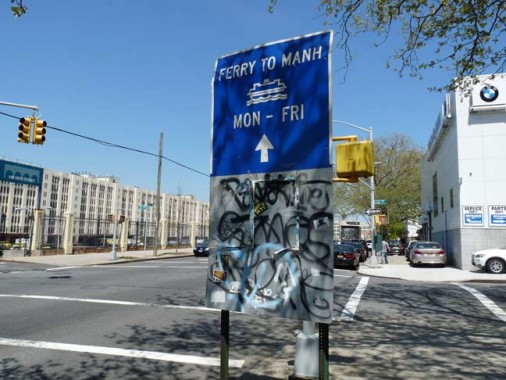
Following the signs to the ferry. For the past couple of decades there has been a ferry from “Bay ridge” (though this is Sunset Park) to Wall Street off and on (it keeps getting cancelled and reactivated from time to time, but it’s currently in service until at least January 2014, when full service is restored on the R train between Brooklyn and Manhattan.
It’s the successor to another ferry that ran prior to the opening of the Verrazano-Narrows Bridge in 1964. Services using smaller boats ran from the 69th Street Pier periodically from the 1960s through the 90s, but the service swithced to a larger pier at 58th Street.

The ferry is walkable from the 4th Avenue BMT 59th Street subway, but it’s easier to take a bus. The B11 bus serves the terminal and also the nearby Lutheran Hospital. It transfers to the BMT at the 53rd Street station.

The rail tracks along 1st Avenue leading into the BAT serve Brooklyn’s only railroad still running on a street open to traffic.
The Bush Terminal Railroad was built to provide service to Bush Terminal tenants and was a key element of the integration of the facility. Sidings into all buildings from rail arteries running down the avenues allowed materials to be be directly transferred to and from rail cars, eliminating the difficulty and expense of transporting products to and from rail depots by truck at a time when rail transport was the primary mode of conveyance for all but the shortest distances. The railroad was linked to the rest of the country either by float bridges at 51st Street or the LIRR Bay Ridge Line at 65th Street. In its early years, the Bush Terminal took responsibility for rail freight transfer on the rail line, with the tenants only responsibility being to get their items to/from the transfer lobby via the freight elevators in all buildings.
The railyard was located just to the east of the terminal warehouses and occupies the six blocks between 44th and 50th streets. At its peak, the railyard could handle 1,000 cars.
The rail system also included smaller team track yards at 29th, 37th, 39th, 48th and 54th Streets. Such yards are so named because in an era before trucks, teamsters with wagons and teams of horses would come to such yards to load and unload railroad cars.
The New York Cross-Harbor Railroad was formed in 1983 to take over the underused facilities of the Brooklyn Terminal Railroad, Brooklyn Eastern District Terminal and the New York Dock. The facilities later came under the perview of the New York New Jersey Rail, providing rail carfloat connection between Greenville Yard in Jersey City, NJ and the Bush Terminal in Brooklyn. Michael Minn, who has additional photos of this unusual railroad.
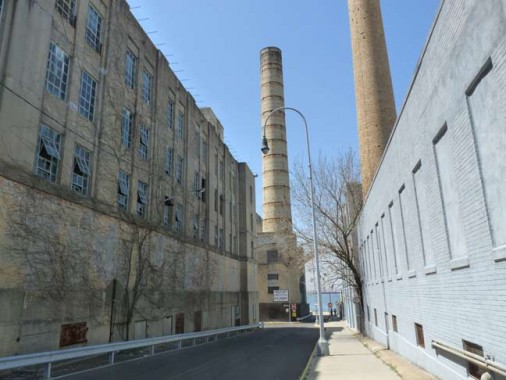
The road to the ferry passes some semi-abandoned warehouses and smokestacks belonging to the BAT power plant.

At first I thought this referred to a party boat. You’ll have to help me with this, as the internet is silent about what the phrase means, other than the obvious.
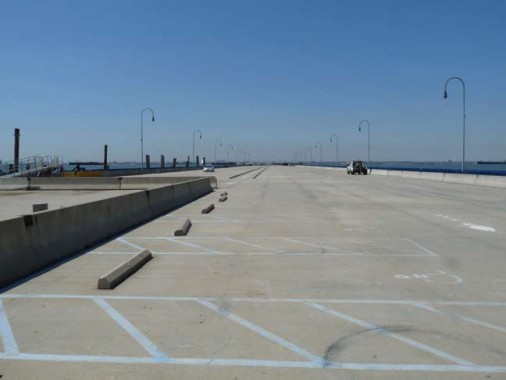
The first boats launch from the Army Terminal dock weekday mornings at 6:20 am. Another boat departs at 7:10 am, followed by ships at 8:20, 8:50, and 10:05 am. They dock first at Wall Street, then head upriver to East 34th Street. Fare is $2 one-way, and commuters can skip the train altogether by paying $2 to ride the shuttle van that picks up passengers above every Bay Ridge R stop starting in time to make the 7:10 ferry. The shuttle stops at 95th Street and Fourth Avenue 40 minutes before each departure, at 86th and Fourth 35 minutes beforehand, at 77th and Fourth 30 minutes early, and at 69th Street and Fourth 25 minutes prior to launch. The Brooklyn Paper
It’s one of NYC’s least-known ferry terminals. Views across Upper NY Bay and the Narrows can be had, providing views as far as the Statue of Liberty and Jersey City.
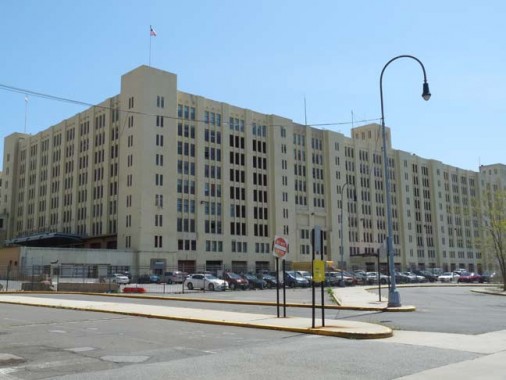
The waterfront end of the BKLYN Army terminal. The most surprising thing here, to me …
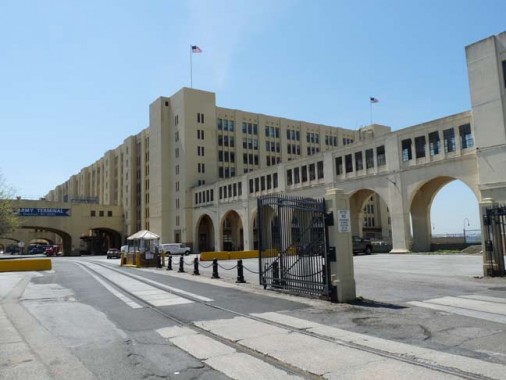

… was the pedestrian bridge between complexes. I hate to be ambiguous, but when I took these, I was reminded of a bridge in Italy (I have never been, but have seen photos). Now I can’t remember which one I was thinking of. Once again, give me a boost.
I can say it’s one of the more impressive pedestrian bridges in NYC no one knows about.

Lutheran Medical Center, 2nd Avenue and 56th Street. Lutheran was founded in 1883 by a Norwegian Lutheran Deaconess-Nurse, Sister Elizabeth Fedde, to serve the Norwegian immigrant community. The institution has provided care for the southwest Brooklyn communities for more than 80 years. My father was treated here for his final illness in 2002-2003.
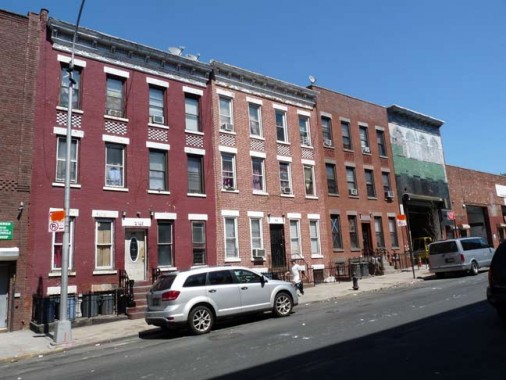
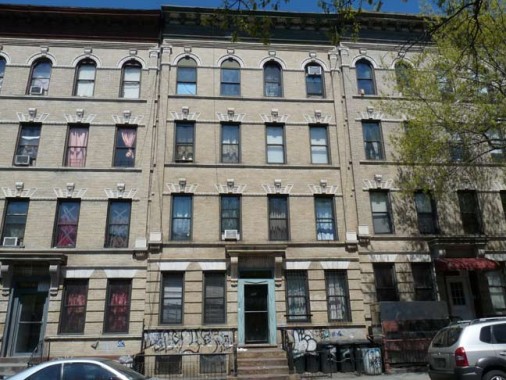
Ascending the hill on 58th Street going southeast. The housing units here have survived fairly intact, without a lot of alterations, from the early 20th Century.

Sunset Park is mostly Hispanic these days, but Irish Haven, 4th Avenue and 58th, may be a relic from the days when the Irish held firm.
And with that, time to get home before the peak fares kicked in at 4PM.
10/26/13


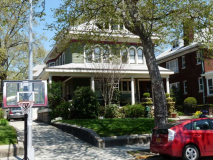
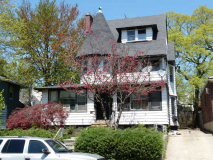
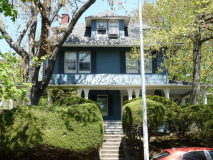
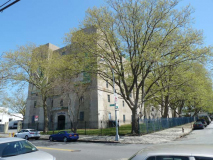
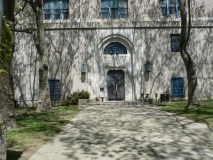
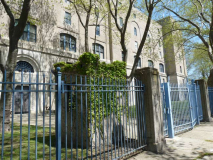
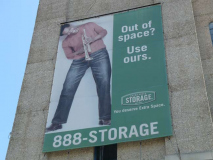
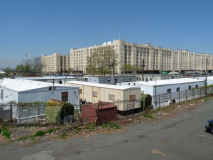
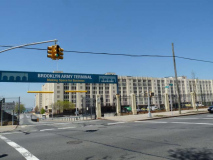
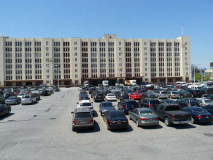
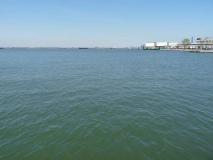
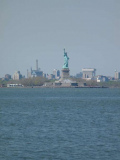
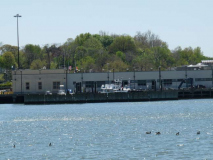

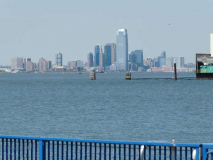
39 comments
Kiss & Sail – I think that where drivers drop off ferry riders, separate from those who drive & park.
I heard this 2nd Avenue freighbtrains where the last street trains in NYC, but they might not run anymore. Please share if you know otherwise. I saw a photo from 1988, when the Williamsburg bridge was closed for repairs, and a diesel was pulling a train of subways cars to the 39th Street (BMT) yard because the BMT Eastern lines were isolated from the rest of the system, including Coney Island for repairs.
Right. Kiss and Sail is modeled on the “Kiss and Fly” name for airport drop off areas.
https://www.google.com/#q=%22kiss+and+fly%22+airport
Regarding the bridge, Kevin, I think you might be thinking of the Ponte Vecchio in Florence. I’ve never been there either, but this kinda looks like the photos I’ve seen of it. (The name means “Old Bridge” in Italian.) I’ve also never figured out why we call the city Florence when in Italy they call it Firenza.
Heck, why did the Anglo-Saxons meddle with so many names and words? That’s how we got Gravesend.
Florence is the Anglicized version of Firenza, as Rome is to Roma, Piedmont is to Piemonte, Milan is to Milano, etc.
The bridge looks like the Pomte Vecchio in Florence
http://www.sights-and-culture.com/Italy/Ponte-Vecchio-7625.jpg
Hi.
On this website, you state that:
“This monolithic behemoth at the corner of 2nd and 64th Street looks like it could survive a couple of Hurricane Sandys. I wonder what its original purposes was. It is now home to Extra Space storage. The exterior is fenced off pretty securely. I stuck the camera through the bars for some photos.”
I grew up in the Boro Park section of Brooklyn and took frequent bike rides to this area. I believe the building in question was a US Government Magazine housing guns and ammunition.
Love the entire Forgotten NY website.
Kiss & Sail refers to a passenger dropoff area. More common at commuter transit locations is Kiss & Ride.
According to the AIA Guide the building at 2nd and 64th is the former N. Y. S. Arsenal. The authors give no architectural details but consider it “grim”. It reminds me of some of the school buildings I have been in over the years.
Kiss and Ride is exactly what it says. You kiss the person who is delivering you to the transportation. That person drives away and you get on the ferry, train, or bus. Cute way of saying spouse or child gets to keep the car for the day.
Wasn’t there a huge mansion type house with a very large yard next to one of the stair streets. By looking on Google maps, it appears to be gone. Do you remember the place?
Kiss and Sail: Kiss your spouse goodbye that left you at the ferry and sail away.
Park and sail: Park it and sail away etc.
The Ponte Vecchio ( the “Old Bridge”) in Florence.
“Kiss & Sail” Is basically the same as “Kiss & Ride,” i.e., an area where standing, though not parking, is allowed, for the purpose of an automobile passenger alighting to take another mode of transportation. The image conjured up is that of Mary driving John to the train station, where she stops the car by the curb of a long more-of-an-oblong-shaped traffic circle, whereupon John kisses her goodbye, he exits the car, and she drives off, while meanwhile other Mary’s and other John’s are doing the same.
“Park Slope is mostly Hispanic these days…”
Huh?!? What decade are you in?!?
Sure, in that part of Sunset Park. East of that it’s mainly Asian.
Kevin, what kind of Irishman might you be? The Irish Haven is in Sunset Park. Wait till Tony Giordano hears about this. Park Slope has creeped south at the whim of real estate people. Park Slope doesn’t include Fifth Ave. south of Ninth St. South Slope is a monetizing fiction.Sun Park ‘runs’ to 36th St. including of course ‘Finntown’. I admire your work. You are unique. Personal note: I was editor of the Home Reporter and Sunset News when you were a kid growing up in Bay Ridge. We ‘made’ the real functional boundaries.
You’re right, perhaps a brain condition at age 56. I replaced it with “Sunset Park”
The bridge that came to mind immediately that you might be thinking of is the Ponte Vecchio over the River Arno in Florence, Italy
http://en.wikipedia.org/wiki/Ponte_Vecchio
I did construction work in the BAT (Brooklyn Army Terminal) and the former Armory on 2nd Ave between 63rd & 64th streets when they were converted to commercial use. I don’t remember the formal name that the Armory was known by, but it’s now that Extra Space Storage facility. I wish my father was still alive because he piloted the PRR Tug Johnstown before WWII which was based in the PRR Greenville yards in Jersey City. Many of the cars he floated were to The Brooklyn Eastern District at the BAT and Bush Terminal. All his stories and memories of that went with him. Sad.
Kevin, the “Kiss-and-drive” (or whatever) is a reference to a drop off point for the spouse, partner, or significant other (does that cover all the possibilities?) to let the passenger out to board the bus/train/plane/ferry/or other conveyance.
Kevin, just an aside about the building that houses Lutheran Medical Center. My father worked there before WWII as a runner. The building was then wholly owned by AMF (then American Machine and Foundry). On his lunch hour he would dip down the stairs to their research labs and bowl on the forefather of the automatic pin-setting machine. Prior to that , the pins would be set by actual people, usually small ones…
I worked for the BUSH/NEW YORK DOCK RLY 1976/1978 after ConRail crashed the old PC,as clerk..we operated along both 2nd and 1st Av and had customers all the way from 58th Street and 2av to the hospital and into BAT(were we linked with the old LIRR/MTA)we car floated freight from Greenville NJ(former PRR yards)to 1st Av yard next to the old Naval Guards building on 41st St…left NY in late 1978 for job with Union Pacific RR(retired in 2006)….we moved a great deal of freight down the middle of the street…..
The boats used on the 69th St – Staten Island Ferry were, of course, made surplus by the Verazzano Bridge, but they served several more years on the Chester, PA to Bridgeport, NJ ferry before again being bumped by a bridge – the Commodore Barry. Some of them carried an odd, to me anyway, legend painted on the side “Electric Ferry”, they were diesel electric.
Like you, I suspect, I always used to love paging through my Dad’s well-worn Hagstrom NYC atlas books. I was (still am) intrigued by the 69th Street ferry to Staten Island, as it was marked in Hagstrom as “electric ferry”, and I don’t recall other ferry routes having their mode of power designated.
Anyone know what was special about the “Electric Ferry”? Would answer a question I have always wondered about!
Harry Volpe
The “Electric Ferry” name meant that it was diesel-electric powered, as opposed to many of the other coal powered ferries the service the NYC area. The long-gone 125th Street-Edgewater (NJ) ferry was also another “Electric Ferry” service. I used to ride this line when my mother and I went to Palisades Amusement Park.
Whoops – sorry; I forgot the gentrification express hasn’t reached there yet (thankfully).
It’s less Irish, Italian, Scandinavian and Syrian than it used to be
I thought Bay Ridge was becoming increasingly Middle Eastern.
Indeed it is; 69th Street’s new alternate name is Beirut Avenue.
The 2nd Av./65th St. signs were installed by the contractor who replaced the bridge over the tracks about 10 years ago or so…I can only speculate that they damaged or lost the originals?
As others have commented, the building on 64th and 2nd was an arsenal for the NY State National Guard. I remember the military trucks being stored in the building when I was a kid (1970’s). The walls are several feet thick. The house someone referred to bordering the step stairs was on the north side of 75th Street, overlooking Colonial Road. It was torn down in the early 1980’s, without permits, when they began talking about trying to landmark it. Some rather less interesting triple deckers went up in its place. There was a fence with the name of the property on it – The Ridge. That name is shared by the massive apartment building that bordered the property on the east. There is still a large house on the next step street on 74th, but not nearly as large. Interesting thing about that house is much of it is underground. You enter the garage from the bottom ot the step street, but the house is at the top, so there are several levels underground, with windows in the side of the hill.
So sad. I remember the house that adorned the corner of Ridge & 77th. I walked pass that house for many years walking up to 4th ave. to catch the 8:15 into the city (actually the RR). I’ve seen some fugly places going up lately and I hope the trend stops here, not like what was put up on the old Schaefer’s parking lot behind the courthouse on 4th & 42nd.
Very informative piece Kevin. Thanks for introducing me to a part of Bay Ridge. I never spent much time in there except from glimpses from the Shore Parkway or the Gowanus Expressway, when we were New Jersey bound for the Verrazano Narrows Bridge. I’m glad I got to see what lovely Victorian homes and other period homes, and tudor and art deco apartment houses that grace some of the the streets of Bay Ridge. I hope someone is working on landmarking those structures so this unique community won’t end up losing these wonderful historic architectural treasures.
The drop off area for passengers heading to the Journal Square PATH station is called “Kiss and Ride” I am sure this what “Kiss and Sail” means too.
http://www.brooklyneagle.com/articles/ridge-boulevard-home-demolished-leaving-flood-memories-behind
There is controversy over the house that was torn down. The developer did not receive permission to demolish the building, only to remodel the interior. That is why nothing has happened on the lot for quite some time. The link above is for an article about the matter in the Brooklyn Daily Eagle.
The Armory building was also used as a morgue during WW II. I had a storage space in there quite awhile ago. While I was there, employees of the Jim Henson (the Muppets guy) were cleaning out several units that were used to store old props. Allegedly, they re-discovered the original Kermit the Frog puppet.
I used to live on 75th St. between Ridge & Colonial
Loved the pictures, brought back a lot of fond memories
Both sets of my grandparents lived in Bay Ridge on 3rd Ave and Ridge Blvd. I remember visiting as a kid from Long Island and loving “the city”. Great photos and thanks for the memories!
In the grouping of pictures that shows the Statue of Liberty and NYC skyline is a beige building and a stand of trees on the water with some white vehicles behind a fence. Those are the flybridges of NYPD Harbor Patrol boats as that is a Harbor Patrol Station (Precinct?). I was coming off the hairpin turn 65/67th Street Exit on the X37 “Express” Bus and saw an NYPD Aviation helicopter land there. Really cool.
I take the old boat near there every now and then. Also ride a bicycle to work near the 2nd Avenue Brooklyn Army Terminal entrance. I often wonder if the carfloat terminal at 65th Street receives barges. I see the trains run along the sidings with the light blue locomotive. But never have seen barge traffic there. I have tried to look around at the other one in the 40s and 1st Ave but it’s too secured. There used to be a restaurant (Massa’s?) on 43rd Street in a stout brick house inside the gateed area. Gone. I love hearing the train horns when they sound off. I live across the street from the green house pictured.
I also remembered The Ridge. Sad to see go away. On my block on 77th Street there was a large 4 story big grey house that had the nickname “Big Gray”. Built in 1910?? I have a picture of the place when it sat all alone. It was owned by a church for a while and had a lot of occupants. There were parties there every now and then and the neighbors would come and was a nice time had by all. One of the band members from Blondie lived there for a while. It was sold to someone eventually who tore it down and is putting up some … thing (still under construction late 2014). With all the $$ going into the property now, the house could have been made to be a real jewel. Still boarded off.
There is another “mansion” on 76th Street at the tops of the steps “below” Ridge Boulevard. I think it’s multiple family occupancy now, but still a nice property.
vsk
I lived in the house on 77th Street called “Big Gray” for many years. in the 1980s. I absolutely LOVED that house, as did most of the other folks who lived in it. I was so very sad when I found out it was torn down. I would love to get a copy of the picture where the house is sitting all alone when it was first built. I saw that picture once upon a time, but don’t know how it find it. Can you help?
Thanks for mentioning Big Gray!
I just saw the post above from my old Big Gray housemate, Joyce. That old mansion was actually built in 1895. There are pictures of it in the archives of the Brooklyn Historical Society. The Big Gray Comnunity founded in 1975, survived for 21 years till ‘96.t It was home to many musicians, students and struggling artists who rented it from a church in Park Slope who owned it from 1972 till ‘96 when it was put up for sale and eventually old to the
musician from Blondie. He was unable to maintain it.